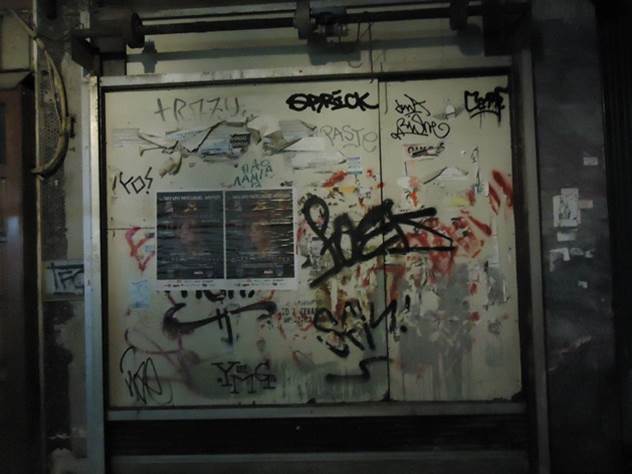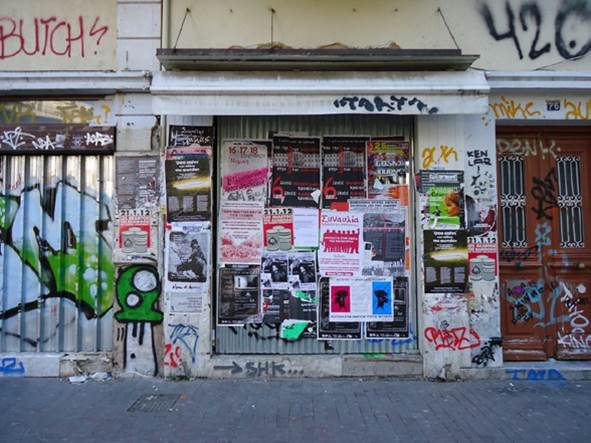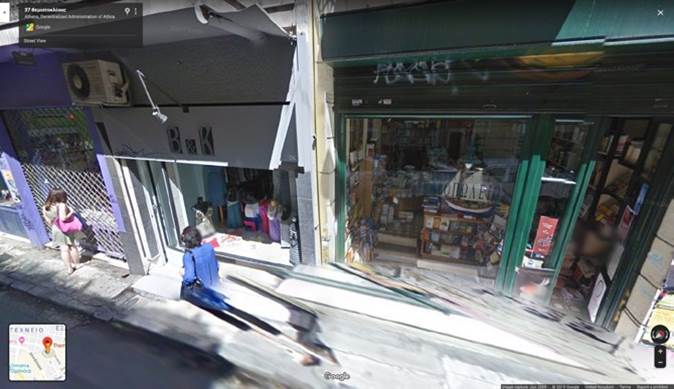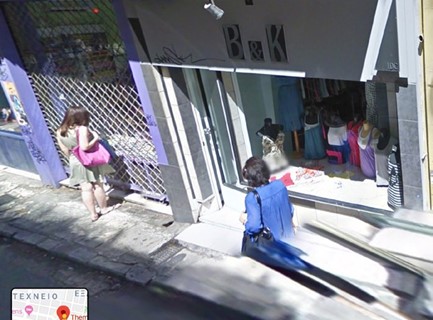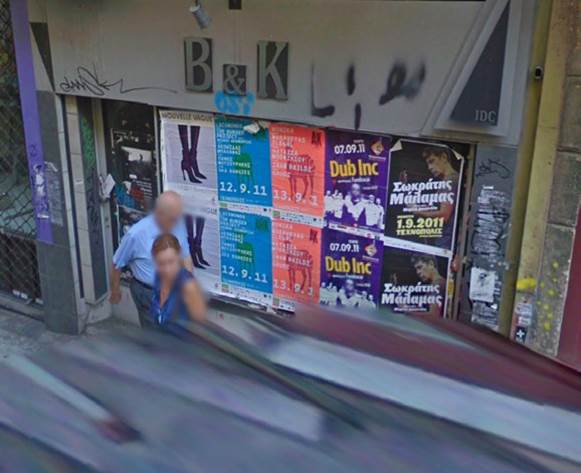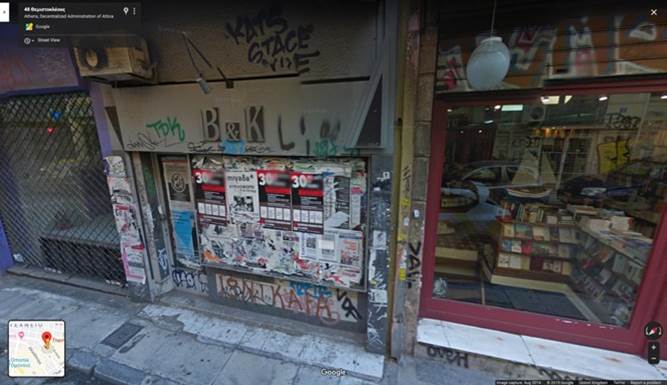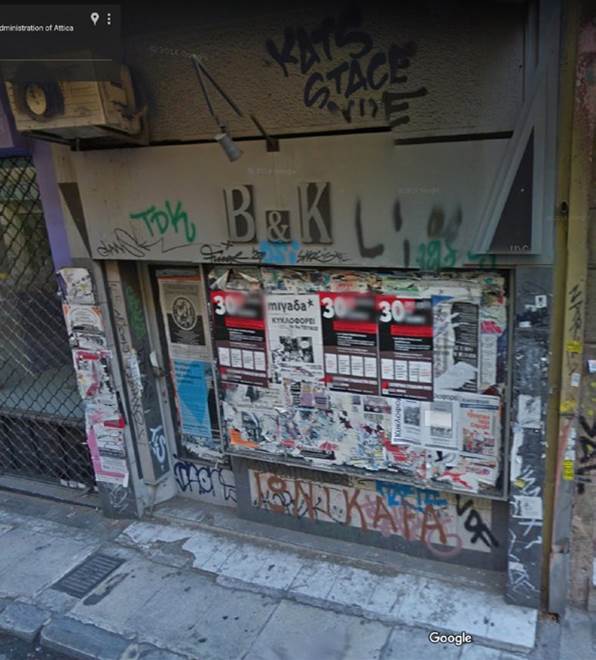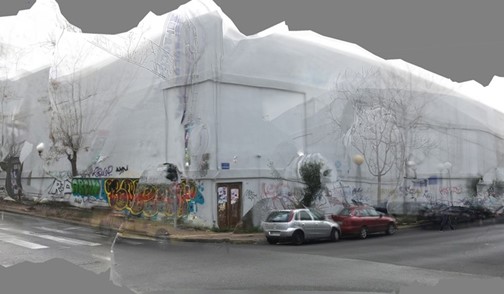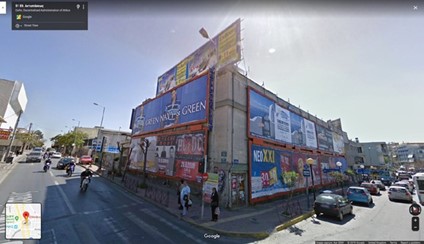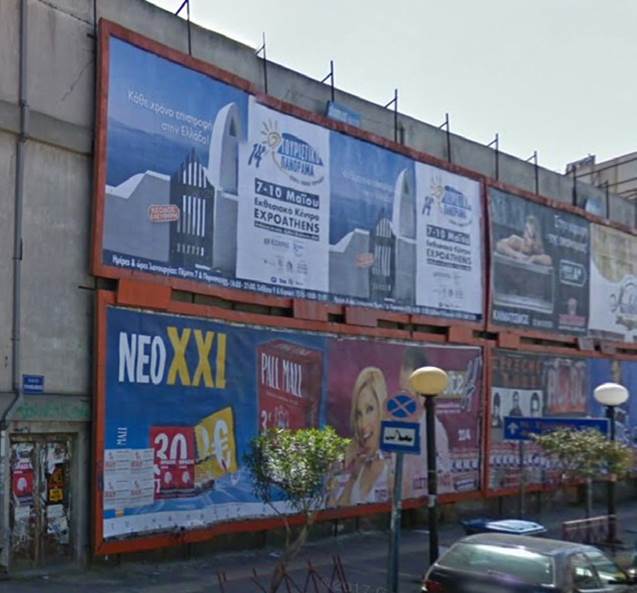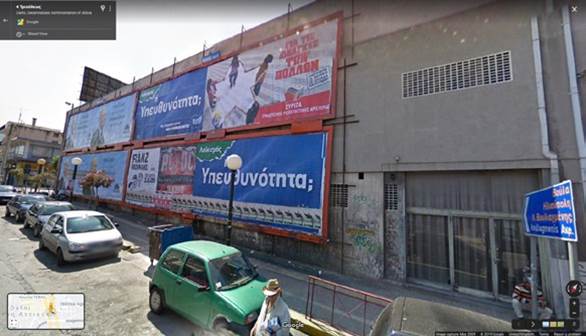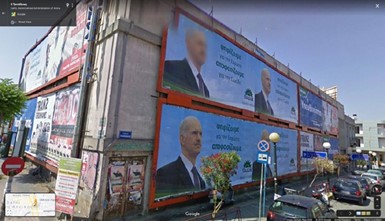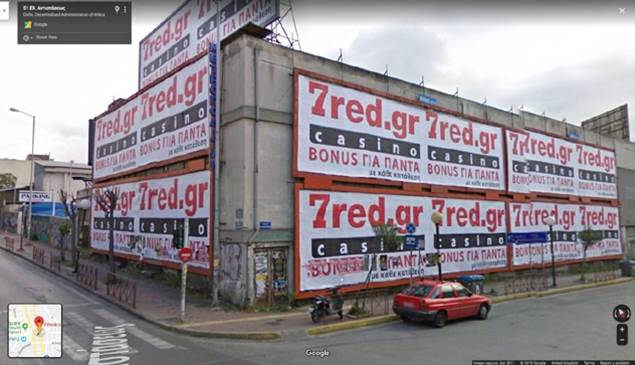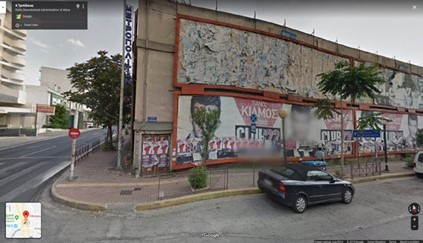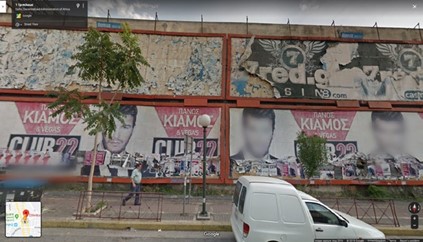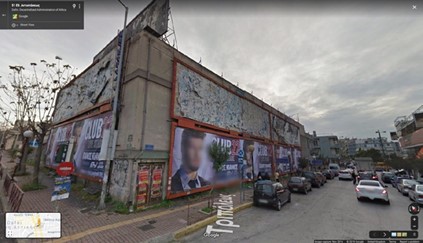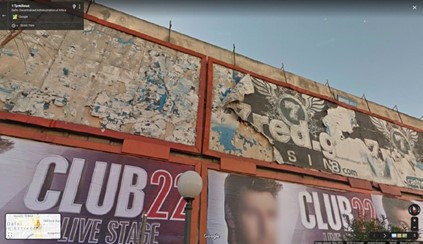Attempting to Approach the Idea of the Derma and Its Features
Athens in crisis has provided a unique case of the public’s engagement with the urban surfaces to the extent that one could discuss the existence of a distinctive city skin, a derma. This article discusses the extension of this phenomenon in time and space, namely throughout all the recent years of the crisis (2008-present), and its deployment as a “contagious” dominant form.
This skin has been covering the architectural volumes with always updated political information, colour, texture and various matters. Public writing and graffiti have politicized the city’s cultural palimpsest, codified forms of protest against dominant political narratives, and also turned the traumatic experience of the crisis into a source of inspira tion and cultural creation (Zaimakis, 2015, p. 119).
Thus, we can review the case of Athens in crisis as an urban collage, where public echoes, the “voices of protest” (Zaimakis, 2015, p. 119) endeavour to find their place and inscribe collective memory and the history of the crisis in a visualised way on the surfaces of the cityscape.
Public writing and painting activity in Athens could always be discerned to a certain degree. In The Walls Belong to the Crowd (Peponis, 2008), published in pre-crisis period (July 2008), the author provides a panorama of visuals, mostly displaying slogans and a few graffiti, since 1977, a few in 80’s, 90’s, and 2000’s. The preponderance of them charts the socio-political developments from 2000 on, with a great deal of focus on 2007 where resided the most subversive ones. They comprise a potential historical documentation of political narratives on the Athenian surfaces for three and a half decades. However, since 2008 and while Greece was leading to an increasingly deeper recession, the derma proliferated and rapidly covered the city.
The financial domino of the economic crisis caused a number of chain reactions due to the linkage between economy, market and society. For example, the average annual income in 2008 - at the beginning of the crisis - was 28,418€, before salaries started to drop as a consequence of the crisis. In the year 2017 the lowest average annual income could be observed, that was 7,956€. Considering the above, one can speak of “impoverishment” of the population of the country (Sakellari, 2019, para. 10). This impoverishment that affected the consumerism ability led to the economic domino finally impacting on the whole Greek society. The crisis has had significant costs in terms of product, income and wealth. From 2008 to 2016, Greece lost more than 1/4 of its gross domestic product at constant prices, while the unemployment rate increased by about 16 percentage points (Stournaras, 2020, para. 8).
During the years of Greece’s economic crisis, the practice of public painting and writing acquired unprecedented dimensions (Karathanasis, 2014, p. 178). Pangalos (2014) states that there is “an unforeseen concentration of writings (the whole spectrum of graffiti practices and versions) on the city’s vertical surfaces, rendering it one of the most stained and saturated cities in the world” (p. 154). The public’s conscious or unconscious tendency to be more engaged with the urban sphere testifies how a mere wall writing starts becoming a phenomenon of tailoring a “skin of crisis” since the very beginning of it. Kalofolias (2013) observes that
after December 2008, graffiti multiplied. Their tone of voice changed, humour and irony receded, and more agony and anger emerged. It was only natural. The cry of the youth was spurned with rage by dominant speech and was left suspended in the air while destruction came, the city sunk in the vortex of social nightmare… (p. 5)
In fact, in December 2008 there was a number of riots and protests attended by Greek teenagers and young adults, and they were stimulated by the murder of a 15-year-old student, Alexandros Grigoropoulos, by a member the police. Nonetheless, they were not the marginalised; as young members of the middle class they demonstrated against the government’s impotence and corruption. They were outraged by fake political pledges of an education system that could only promise them that they would work harder than their drained parents. Their options were either to become the so called “700€ gen eration” or leave abroad as many other skilled young Greeks were forced to do, instead of enduring a bureaucratic and disorganised state (Margaronis, 2008, para. 3-4). However, how the act of marking the walls with visuals, for example, graffiti, in places where the youth gathers (such as the universities) can function as a route towards emancipation and a definition of a new identity of the “young generation of crisis”?
Within the framework of the long-established crisis the expansion of the protest graffiti as a “striking feature” became the anti-austerity response of young writers as they attempted visualise their own readings of the crisis (Zaimakis, 2016, p. 67). The shaping of a political identity reflects how the youth responds to the political reality and issues of politics, education and social reality that surrounds them; their markings are “an expres- sive, unconventional, intrusive, motivating, improving and mainly a subversive means of expressing their ideas and opinions” (Kalogiannaki & Κarras, 2013, p. 12). Looking at similar statements, one may chart the qualities of these urban political forms, and hence understand the nature of the wholeness, namely the skin. Kalofolias (2013) notices that
these forms are intruders on your visual field without being invited, demanding part of your attention or beseeching it; thoughts pleading for a place to be communicated in tandem with the action that witnesses emergency. Omens of the city, present in any turbulent historic period, conveying a message of an event to be read just before or after it occurs. (p. 5)
In fact, the walls assert a language on their own, a language that is “unique, dynamic, charged, subversive, often harsh and ironic, provocative and cynical, authentic, often politicized, but also a colourful, a multifaceted and artistic language” (Kalogiannaki & karras, 2013, p. 12).
Although these statements do not refer to an idea of a skin or the immensity of the phenomenon, they identify aliquot ingredients that finally compose the general and omnipresent form: the collaged skin. Indeed, they incarnate an emergent quality of subversion, necessary for facing the crisis and struggling, mentally or physically, against it.
Hence, if the surface of Athens in crisis was examined as a collaged form, that would be the subversive collage. Subversion is the central quality of collage; the collected material is deprived of its principal context and its embedding in new compositions is an act of subversion, a form of protest (Busch & Klanten, 2016, p. 2). The subversive strand of collage can be examined in the urban sphere of Athens related to its “skin”, through the way how people react with the architectural volumes and objects found in the cityscape. Their initial role and function seem to be rather obvious and ordinary. Yet how can they be transformed into “social diaries”, into “a terrain of conflict and metamorphosis” (Tsilimpounidi, 2015, p. 18) expressing a more general public disappointment, finally composing an “urban collage” of protest?
Peponis (2008, p. 9) argues that although the walls are the most suitable place for the writing of slogans, any other space becomes available, both as a receiver and transmitter of messages: benches, entrances of apartment buildings and sidewalks are regularly converted into communication means. Zaimakis (2016) mentions that “surfaces on historical buildings and banks, shabby walls, viaduct poles, rubbish bins, shop windows and derelict houses” allow room for the writers to render “the visualized city more vibrant, intriguing, and protesting” (p. 70). We see therefore that, on the one hand, there is a necessity for space, as if the space is never enough. On the other, the unprecedented expansion and density of collaged elements simultaneously account for an inquiry of examining a “skin”, rather than its mere individual constituents:
painted trains, walls, window screens - a multi-coloured collage taking over the city, a threat that state as well as private individuals are no match for. (...) Every effort made for “cleaning the place up” has become just a memory. Everything is overpainted - a heaven for writers - and we really feel like home. (Pissa, 2012, p. 3)
This collaged derma is a living, dynamic organism that is transient and non-resistant to time’s effects. It may occupy a space that may become larger or smaller, itself becoming larger or smaller. Instead of a timestamp of creation, because of its organic development, it exists as a breathing entity in a time-range.
Let us consider how younger generations, in particular, have faced the crisis and grown up in this urban environment and visual culture surrounding them. The sense that during a crisis everything is transient and momentary is also reflected on this skin, being in a process of incessant change as well. “Things change rapidly. Used up words like crisis and depression have taken hold of everybody’s mind. Not just in terms of economic advancement, but of the whole western culture…” (Pissa, 2012, p. 3). I intend to approach how the recording of this ephemeral state, for both individuals and their cityscape, is essential for further reading a crisis through its visual evidences: the omnipresent human trace. This understanding may help us realise how our surrounding environment - our tailored skin - is a mirror of our economy, social and political life, and in the end of our culture.
A Methodological Study of Athens: A City in a State of Socioeconomic Emergency
Throughout the years, the economic strand of Greece’s financial crisis has influenced and altered the visual imagery of the urban sphere. The public cityspace visually reflects the consequences of the financial domino.
As far as my practice-based methodology used in this article is concerned, I have been engaged with photography, 3D modelling, photogrammetry and Google Maps potential. An early photographic attempt of the Athenian cityscape’s alteration occurred in December 2008, when I took images of slogans, stencilled visuals and messages in the aftermath of the protests in memory of Alexis Grigoropoulos’s murder by a policeman. At that stage, these slogans functioned as “stencil-acts”, “calls to struggle and forms of struggle”, and they were the invented medium of an uprising to be coming (Stavrides, 2017, p. 166). However, as I above explained how the financial strand of the crisis influenced the Greek society, the considerable visual realisation of the crisis occurred when people began to confront the images of closed stores. This change within the urban imagery was connected with the sudden and in massive number closure of stores, in particular in the city centres. Athens downtown, once lively and vibrant, it gradually became a landscape of ruins. “The ruptures created in urban space by disinvestment, austerity and years of political struggle constantly produced new surfaces and spaces: boarded-up urban ruins, unfinished buildings, vacant shop windows, and decaying billboards with nothing left to advertise” (Tulke, 2017, p. 202). A germinal photographic phase of my current research took place during the first years of the crisis, when I photographed a number of closed stores in Athens city centre (2011 and 2012). Although the term “street art” is commonly used to refer to self-authorized visual and material interventions in public space (Tulke, 2017, p. 204), my shift towards photographing the closed stores (and different stages of their visual changes throughout the years of the crisis) focused on the metamorphosis into ruins. Since 2018, I adopted 3D scanning and photogrammetry to re-build the scanned city spots. As the photographer Jonathan Miller (1999) stated for his fragmented urban images “it’s difficult to reconstruct the scenes from which my bits have been captured” (para. 4). Given that technological advancement contributed to the 3D processes, I adopted that digital tool to revive the scenery in detail, a possibility that mere photography could not provide. Since this research initiated in 2018, and only a few documentations of the displayed spots were recorded, I relied on GIS potential and Google Maps for retrieving past city layers. Certainty, this virtual exploration of the past is limited, providing that only a few and fragmented time-lapses were available. In the following pages, I will present this “metamorphosis” through visuals as well as the crossing from the one technique to the other.
The gradual consequences of the crisis: the stores have massively been closed, and in the place of the prior shopfronts (displaying commodities and products) we now notice alternative appropriations of the space.
In the Figure 1, we can see a closed store near Omonoia square, Athens city centre. Wood panels have covered the former showcase, probably to protect its glasses. Samples of torn posters indicate that layers of posters have been removed, and a prior layer of spray-paint writing activity was unveiled. The image witnesses spatiotemporality: while looking closely to the two remained posters of the image, we slightly detect information of a musical that took place on November 19, at The Athens Concert Hall.
In the Figure 2, we can observe two closed stores (in the middle and on the left), probably in Valtetsiou street, covered with steel panels. The panels served as canvases or “notice boards” for various activities. Graffiti, tagging, slogans, and the dominant element: the posters. Equally, in this case the posters provide spatiotemporal information (dates in December and January are indicated, and different places in Athens).
By meticulously examining Figure 2, the context provided by the posters is mostly socio-political relevant to events that occurred during that period. Indicatively: a call for an assembly for direct democracy, a 24h Attica strike, a concert in support of the strikers in steel industry. A poster in memory of the 15-year-old student Alexandros Grigoropoulos, murdered by the police, states: “3 years after the uprising. From the government of murderers to the government of fascists”. Other posters state: “resistance and action for the freedom of… (an anarchist&)”, “sirect action”, and so forth. At this stage, it is essential to stress that the visual activity, in general, covers all the provided surfaces: metal, marble columns, walls, the tent, even the neoclassical wooden door on the right. The detection of this expansion in accordance with a necessity of space makes clearer my hypothesis of the “derma”, the skin of the city and its context during the economic crisis. It moves beyond ideas such as the “overpainted walls” referring to slogans and graffiti (Karathanasis, 2014, p. 178), “overwriting the city” for “graffiti’s role as a form of strategic communications in areas of social and political crisis” (Kim & Flores, 2018, p. 9), and graffiti as “a testament of creativity and artistry” (Stampoulidis, 2016, p. 10).
Retrieving Past City Layers: A Décollage Approach
An access to prior city layers in order to retrieve the visually written history of this urban collage would be possible through a “décollaging” methodology. A décollage is “the opposite of collage. It means ungluing, unsticking, taking off. It occurs naturally in cities when poster hoardings are torn and defaced revealing several layers of imagery” (Walker, 1977, p. 100). This definition implies a material act, a hand-based one or weathering, a tactile defacement as artistic act. Within the framework of materiality, in mid-1960’s Alain Jouffroy (1966) described Raymond Hains as the artist who “prefers ripped-down posters as he finds them, as they appear to anyone in the street, and who with something like awe discovers in them traces of a poetry composed by everyone” (p. 82). Hains’s décollages were the “poetry of the street, archaeology of the collective unconscious” (Jouffroy, 1966, p. 84). Yet, this aspect of décollage appears rather deconstructive. Taylor (2008) sees décollage as a more constructive process:
for if décollage, or the ungluing of paper, is the tearing of parts asunder, then collage, literally sticking, is a constructive attachment of parts to make a new or reassembled whole. But “destruction” and “construction” are imprecise metaphors here. For just as décollage reveals an existing surface beneath, and hence is constructive, collage deals in already detached fragments and in that sense pays witness to a previous dismantling. (p. 9)
Décollage, as a constructive vehicle rather than decomposing, may provide a new role to a decision for a documentation strategy. We can document different stages of the derma, before a new layer hides the prior one, and the forthcoming follows the same course. Hence, a temporal décollaging formula is built that digitally preserves in detail each stage, without any lack of the material in terms of a physical tearing apart. In my methodology, by utilising Google Maps, I explain and examine how décollage shifts to a virtual space and, through technology, it functions as a tool for unveiling fragments of the past.
Case Study: B&K Closed Store. Place: Themistokleous 37, Athens 106 83, Greece
When I first photographed B & K closed store in January 2012 (Figure 3), I was not able to understand what kind of store it was in the past. Both its door and showcase were extremely covered with multiple layers of posters. At first, the slogan below the covered showcase drew my attention: “LAMPROS LIVES”. Lámpros is a Greek male name and literally means “one who brightens”. But written in capital Greek (so the accent is not obvious) it could be the adjective “lamprós”, which means “bright”. This double potential meaning, “light lives”, made me record the whole store. The displayed thick skin of posters’ layering is indicative of the transformation of the closed stores during the years of the crisis.
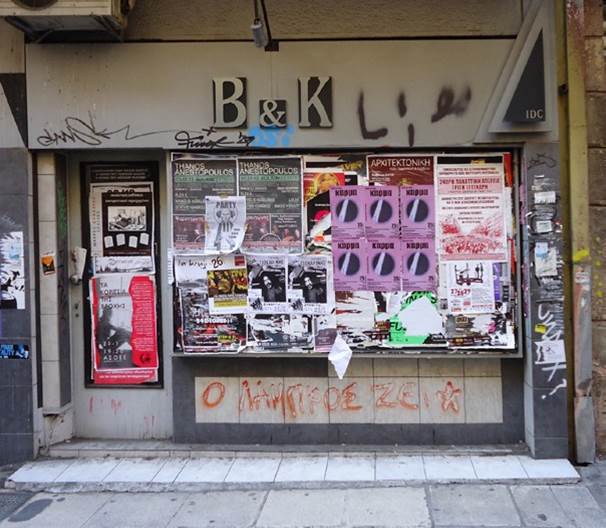
Credits. Panagiotis Ferentinos
Figure 3: January 2012. B & K Closed Store, Themistokleous 37, Athens
Let us consider how Figure 3 may function as a “map” of the specific moment of this capture (January 17, 2012). If a map is “a symbolic representation of selected characteristics of a place, usually drawn on a flat surface” (National Geographic, 2011, para. 1), could this image - as a fragmented symbolic visual representation that portrays the last added layer (the surface) - be torn away and see under the surface? Is there a way to reclaim previous layers and see when this store was still open, what kind of store it was, when the layers of the crisis’ skin started to take its place? Can this de-mapping be a décollaging like the ungluing of paper, the process of taking apart? The reason for this is that décollaging unveils the existing matter underneath and is a constructive process (Taylor, 2008, p. 9). Since December 2018, when I decisively began a periodical recording of city locations, I was only able to preserve fragmentary layers of this reality. One of my projects was B & K closed store, that I had photographed in 2012 for the first time. Nonetheless, what about the layers before the image of January 2012 (Figure 3) and all those after, from 2012 to 2018? For this purpose, I adopted Google Maps’ potential to retrieve past layers. But this peeling away process, “de-mapping” or “décollaging”, is also fragmentary. As I stated before, only a few layers of the past are provided. The skin of the city in crisis has so rapidly and dynamically evolved, that Google Maps (as a methodology) dealing with temporal fragments is also fragmentary on its own. A problematic arises: the skin cannot be scanned or documented in total, only mere representations of it may be achieved.
In the following figures, I show past stages of B & K store’s metamorphosis, and how they can function as layers of reading through them the development of the crisis throughout the years. According to the Figures 4 and 5 , in June 2009, at the beginning of the economic crisis, B & K was open. Relying on them (panoramic and zoomed in), it was selling women’s clothes. At this stage, the only discernible trace of writing activity lies on the left side of letter “B” of the sign. It is a tagging with black marker. A woman was looking at its showcase and another was doing the same at the shop on the left. Both stores were then open.
As we can see in the figures 6 and 7, in August 2011, almost 2 years after the previous stage, B & K was closed. Based upon these two past stages it is unknown when that happened, however its showcase was full of posters and two of them are obviously stuck on its door. Comparing with the image of January 2012 (Figure 3) there is nearly the same activity. Within those 4 to 5 months, the posters’ layers became thicker (Figure 3), so no one tore (or removed) the prior layers apart. In both cases (Figure 3 and Figures 6 and 7) the writings around the sign are the same. The purple store on the left was still open.
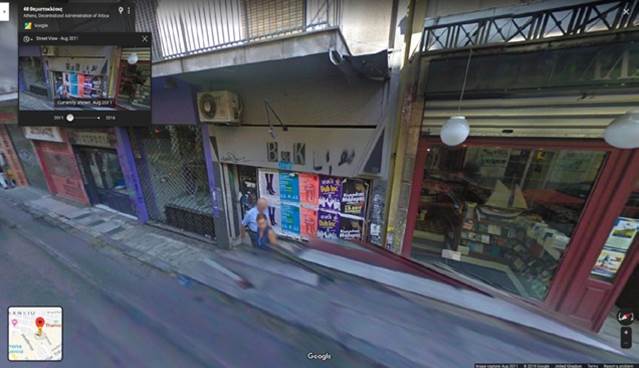
Credits. Google Maps. © 2019 Google
Figure 6: August 2011. Panoramic View of B & K and Stores Nearby
In the Figures 8 and 9, in August 2014, the posters have proliferated and also ex- panded on the column on the left. Any last added poster is placed on top of torn past posters. The writing spray-painted activity has increased. At this stage the spot is so much covered that one could not believe there was once a store at this place. In 2014, the purple store on the left was closed too.
This points out an evidential connection between the crisis and the cityscape, as “since its inception, the city has been a place of fluid normativity, political conflict and sociocultural vibrancy” (Pavoni et al, 2021, p. 5). One could thus have their first visual encounter with the crisis, through the gradually appeared ruins of consumerism. Guy Debord (1967/2014), in The Society of the Spectacle, pointed out that in modern societies where production is predominant, life is incarnated through a vast “accumulation of spectacles”, and the worldview has been materialistic to the extent that it becomes the objective reality (p. 2), In the case of Athens in crisis, what happens when materialism is inactive, and the way of living through the “fetishism of the commodity” - the domination of the world by “imperceptible as well as perceptible things” (Debord, 1967/2014, p. 14), namely the fulfilment of the spectacle - cannot be reached? Indeed, during the years of the crisis the field of the spectacle, the market places that provided commodities, was about to become ruins. Based on fieldwork, periodical recordings in Athens since 2018, and past visual documentation (and their readings), I examine how this “inactive spectacle” is reflected and read on the proliferated skin that has covered Athens.
If we look at the above images (Figures 1 to 9) anew, we can particularly perceive how the poster, due to its material nature (more than the spray-painted writings), started playing a constructive role to this Athenian skin. A poster’s role is to serve the promotional material, to persuade someone of its context (Tripney, 2007, , para. 1); it is in fact a stimulus to communicate a message to the general public (Adom, 2016, para. 1). During the crisis, however, its role to promote products, commodities in general, or even an artistic spectacle or a concert was rather useless. It would be even provocative in its glamorous colours and capital captions. As it was above-mentioned, people were not able to consume, having to pay debts with minor salaries or while being unemployed. How would they be interested in purchasing or even encountering the “spectacle” they cannot afford? This may provide a new twofold dimension to the urban torn poster (décollage) in Athens: the poster that promotes commodities has no reason to reside the city in crisis, it has to come down. Nonetheless, the political poster becomes dominant both in context and presence. This is in the end the major component of the collaged skin of Athens in crisis.
The Athenian Derma: The Urban Collage of the Crisis
If a collage is “a technique of composing a work of art [produced] by pasting on a single surface various materials not normally associated with one another” and “an assemblage or occurrence of diverse elements or fragments in unlikely or unexpected juxtaposition” (Dictionary.com, n.d.), what kind of urban collage would Athens in crisis be? In fact, the surface of the city hosts a number of apparently contradictory elements that finally find a way to co-exist.
What can an urban collage include? A concurrence of various activities’ outcomes: posters, graffiti, tagging, bubble graffiti, signs. In fact, Figure 10 pays witness to this coexistence. Let us try to read the image. On the left, closer to street for gaining further visibility, the eye level view accommodates a series of posters. Posters have to be closer to the eye level and be more accessible for direct replacement. On top of them, so that no deformation is secured, there is a graffiti portraying a face, alongside an air-conditioning box and an abandoned “rotring” sign. With the aid of Google Maps, I confirmed that, in August 2014, this graffiti had already existed, and it has been there ever since. In the middle, a niche hosts posters too. On the right side, mostly hidden and close to the front door of a building, there are three bubble graffiti nearly covering the whole wall. Next to them, three yellow papers indicate “for eent” and “for sale”. The urban skin features a plurality of matters, information, textures, colours, drawing, volumes, and so forth. As the below Figures 11, 12 and 13 display, various city volumes (objects) also host the urban collage’s activity.
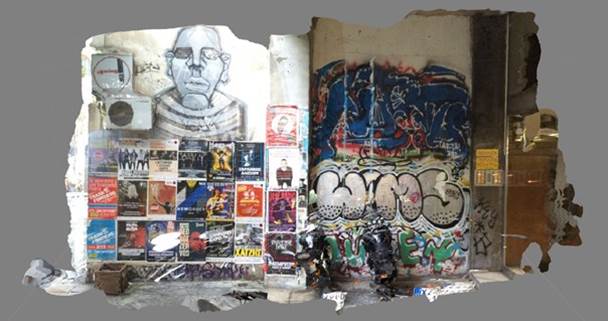
Credits. Panagiotis Ferentinos
Figure 10: Themistokleous 42, Athens 106 78. Image of the Frontal View of a 3D Model. December 2018
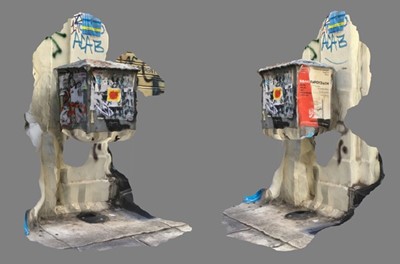
Credits. Panagiotis Ferentinos
Figure 11: Grey Post-Box. Themistokleous 46-48 Street, Athens 106 77. 3/4 Views of 3D Models. December 2019
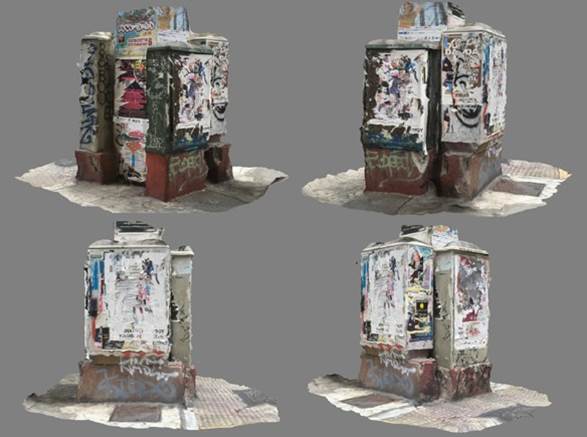
Credits. Panagiotis Ferentinos
Figure 12: Corner of Solonos & Emmanouil Benaki Street, Athens 106 78. Metal Boxes Participate in the Developing of the City’s Skin. 3D Models. July 2019
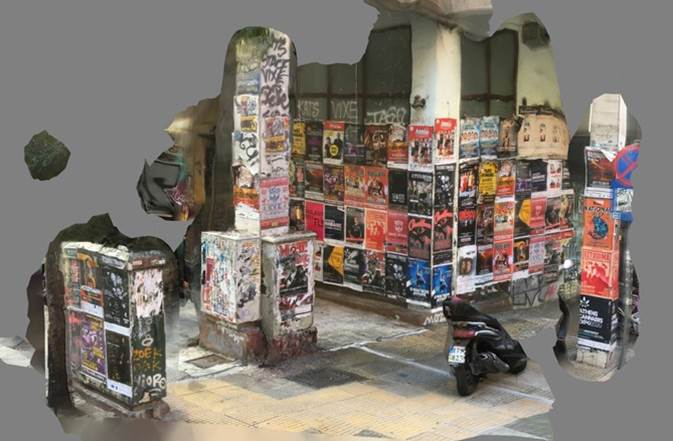
Credits. Panagiotis Ferentinos
Figure 13: A Panoramic View of Solonos & Emmanouil Benaki Street Corner. Walls, Pillars, Metal Boxes, All Covered With Posters and Writings. 3D Model. December 2019
What truly makes collage the medium of our epoch is the fact that it reflects and responds to some of modern life’s key issues and phenomena. Excess is one of our times most pressing concerns, as exemplified by the insatiable consumerism and unmanageable amounts of waste, so collage’s recycling and repurposing of imagery in a world that is also visually saturated is particularly meaningful. (Busch & Klanten, 2016, p. 3)
As a collaging development, the skin of Athens may provide an additional dimension of this “medium of our epoch”. In a place where consumption is inactive and excess can become the proper recycled material, the skin is flourishing. This urban collage consists of layers of the visualised socio-political conditions, and its “precise aesthetic task is to find ways and channels to express socio-political dissent and critique, as well as anger, in the face of a political system that is increasingly unable to represent social demands” (Pavoni et al, 2021, p. 6). The ephemeral coatings are continuously changing and redefined due to the additional material stuck on top of another, to portray the different periods of the crisis. Based on this vigorous process, we argue that the urban collage acquires a historical quality either the layers are recorded or not. If we were to retrieve any previous layers of the city surface, we would have access to a history that was written the very moment it was occurring. How the history of the crisis would be preserved in our time, when the vanishing of a feeling of history, the manner by which “our entire contemporary social system has little by little begun to lose its capacity to retain its own past” (Jameson, 1985, p. 125)? If we were to utilise the visualised information of this always updated collage, we would be able to restore past history from the layers of the surface of the city.
The Urban Collage on the Walls of the Big City: The Unlimited Field of Poetic Achievement
The organic surface of Athens, rich in trace activity under incessant change, can be examined in response to Leo Malet’s statement, in 1969, referring to the “collage of the future” (p. 421). It can be presented a condensed summary for perceiving the idea of Athens as an immense urban collage:
the collage of the future will be executed without scissors or razor or glue, etc. In short: without any of the utensils that were necessary until now. It will leave behind the worktable and the artist’s cardboard surfaces and it will take its place on the walls of the big city, the unlimited field of poetic achievements. (Malet, 1969, p. 421)
Malet (1969) puts the tools (technology) used for its execution first. The very initial sentence is a prediction of the radical change of the media and technology of this future collage (Buchloh, 1991, p. 98). As far as my hypothesis on “urban collage” is concerned, this sentence may rise a twofold correspondence. On the one hand, the variety of mediums involved in the production of it (spray-paint, posters, etc.) and the surfaces en gaged: apart from the walls, even the pavements and various city volumes (post-boxes, buildings’ entrances, columns, etc.) are included. In brief, that is the field within which my city-roaming and fieldwork is realised, providing the collected material for research. On the other, the technology I use does not only aim at recording, but also at interpreting and transforming both this raw digital material and the experience of the wandering into new forms. The shift from the artist’s worktable and cardboard (the canvas) to the walls of the big city, may rise a new question through my research case in regard to Malet’s (1969) collage of the future: is there an intentional collage maker in Athens? Who is this maker when all this activity is bound to the crisis and its echo, and not to mere artistic interventions? Is finally the crisis the maker, sparking the human hand to urban interventions? Although I examine fragments (spots) of the city as case studies, I finally review the activity as a whole. Any ephemeral trace equally advocates the city collage and produces the skin of Athens in crisis.
The Role of the Poster in the City of Anti-Spectacle
The urban poster in Athens of crisis has a twofold role: it is a solid constructive material of building up the “skin” of the city, due to its immense proliferation, and the vehicle of socio-political messages. This poster resists any of a poster’s previous uses as servant of advertising and commerce.
How could, however, the current Athenian poster differentiate itself from the past posters’ exploitation and demonstrate a uniqueness in the present spatiotemporal context of Athens in crisis? In World War II after the Nazis occupation, the walls of the big city would be exploited as a vehicle for political propaganda and fascistic forbidding - any disobedience could cost human lives. After the war, the same walls would accommodate another kind of propaganda, an undetectable form of violence: the recently invented tactics of advertisement, aiming at reviving consumerism in the 1950s (Buchloh, 1991, p. 98). In post-war, Europe artists dealt with the emerging capitalism and mass consumer- ism and attack to the society of the spectacle, as Guy Debord (1967/2014) would call it; and indicative example were the décollagists who sought the physical ripped posters of the urban hoardings to divert their advertising status (Butler & de Zegher, 2010, p. 95). The idea of the torn piece of poster, in collage and décollage, embraced a physical appropriation and material revival.
If the poster in post-war France was a tool of consumption, décollagists’ decision of ripping it was their response against the spectacle. The décollage was a depicted response to the moment that the commodity and its mediums of publicity had invaded into every surface of social life. What actually did décollage to act as a critic of the spectacle and attach it?
Moreover, we are not dealing with one poster but a veritable mattress of posters, myriad skins whose identity has been destroyed by irregular tearing (carried out over time): the strata merge into one another; the lettering grafts together; the words cannibalise one another; information is little by little reduced to undifferentiated noise. (Bois, 1997, p. 178)
During the Greek economic crisis where the poster is unable to have a real advertis- ing role, any decollaging act is constructive: it releases new and “fresh” space for urban activity and all the merged ingredients into one new form lead to the idea of the derma. My investigation aims at unveiling this new identity: the poster to be seen as a narrator of the socio-political, and at the same time a building up material of Athens current imagery.
Defining the Framework of a Current Décollage
A juxtaposition of the conditions within which the post-war décollage emerged and those of Greece’s economic crisis may further clarify what kind of décollage is necessary in my present investigation.
The décollage activity began to occur when in the early 1950’s the spaces of public urban display, the billboards, and the technology for printing the large-scale posters (visual and text) started to fade away. The decline of both spaces and technology gradually attracted the artistic interest. The abandoned sites of advertisement (ruins) and the outmoded technology both became useless for the promotion of commodities with the advancement of the knowledge of engineer (Buchloh, 1991, pp. 98-100). In Athens case, it was the crisis that inactivated the power of spaces and means of advertisement: the ruins are the closed stores, the hoardings were useless, and been gradually been abandoned. Commodities cannot be displayed, they would not be sold. Hence, we do not notice a shift towards another public space or means.
In post-war France, the décollagistes, the anonymous lacerators of the billboards, would realise an artistic rebellion including anonymous gestures of defacement, in an indifferent urban space with an outmoded medium (Buchloh, 1991, pp. 100-101). The anonymity is also a characteristic of the Athenian lacerators, but they do not intend to attack the spectacle of advertisement; the posters of the crisis mostly communicate sociopolitical calls for protests and strikes. Even the advertisement of cultural events (musicals, theatrical displays) that took place in the city could be seen as a protest: although the crisis is devastating, we still invest in culture. As I stated before, in Athens, urban décollage is a way to gain “fresh” space for new information, it is not an act of artists or artistic rebellion. Besides, another décollage is how the mayor of Athens and other private business vanish this skin and whitewash the city I will refer to this case at length below.
The Layers From Pre-Crisis to Crisis: The Constructive Quality of Décollage
Through a peeling away process in Athens cityscape’s surface, we would be able to achieve to recognise the steps towards the visual ruins of the crisis, or even earlier, those of the pre- and early-crisis period that gradually led to a devastating recession. A décollage approach would be therefore a compositional process, a synthesis of past history, and not a further destruction in favour of the crisis. Collage and décollage can only be metaphorically connected to construction and destruction, considering that at the time that décollage flourished, the European city arose from the rubbles of a past war (Taylor, 2008,p. 9). Hence, décollage is the tool of restoring what is hidden and has not be forgotten.
By décollaging the visual coats of Athens’ development, incarnated in the thick layers of posters, we would see an echo of prior forms of consumerism before and at the beginning of the crisis. Yet, while moving deeper into the crisis, could any spectacle succeed in advertising massive consumerism? This advertising has no depth and absorbs all original cultural forms giving prominence to a superficial form (Baudrillard, 1994, p. 87). Instead, the poster coats that belonged to the crisis would mostly witness - in particular those of the city centre - struggling and demonstrations, and a number of culture events that resisted the financial difficult conditions. Advertising resistance instead of commodities has been the new reality.
According to Baudrillard (1994), advertising is an “instantaneous form, is a form without a past, without a future, without the possibility of metamorphosis” (p. 87). Nonetheless, in the case of Athens surfaces this prior advertising had indeed a potential to metamorphosis: it was the very initial layer that gradually led to the skin that has covered the city. Its depth would reflect a struggle against the spectacle, either referring to the political spread information or the immense coverage of it.
December 2019
Ethnikis Antistaseos Avenue & Tripoleos street, in Dafni 172 37 Athens, Greece. The lower parts are used for spray-painted writings and graffiti. The upper part of the walls looks untouched, with no traces of any intervention.
April 2009
I display below the image of the same corner in April 2009. The spectacle of the colourful billboards: expensive brands of clothes and expensive night life.
The upper poster on the left advertises the 14th Touristic Panorama under the slogan “every year return to Greece”. On its right, the poster promotes electronic household’s equipment. On the bottom side on the left, a huge pack of cigarettes advertises smoke. On the right side, a smiling blond lady singer promotes expensive night life.
May 2009
Some months before the Greek elections, on October 5, 2009. On the right bottom and left upper side, there were posters of the political leftish party SYRIZA. The slogans display “Populism [written on the left top corner with small and lowercase letters] or Responsibility [with an immense font covering the whole panel]?”. On the right upper side, the same party’s slogan: “for the needs of all people”.
The face of the politician George Papandreou on the left. He became Greece’s Prime Minister in October 2009 with the Panhellenic Socialist Movement party (PASOK). The slogan on the right side states: “we vote for Europe, we decide for Greece”.
April, May 2011: The Spectacle is the Casino
Both sides of the corner, Ethnikis Antistaseos Avenue and Tripoleos street are fully covered with advertisement of a Casino.
August 2011: The Spectacle Is the Casino
Again, the advertisement for the Casino. In different colours though.
August 2014
The Tripoleos street side. The upper part of the billboard has been abandoned and worn away. A natural décollage took place. The lower part is still representative, but its colours faded away. The lower part advertises a glamorous club of Athens and displays a celebrity male singer.
Both upper sides are in shreds. On the left side we notice the ruins of the earlier casino advertisement. Only fragmented rubbles of the previous advertised spectacle have remained.
November 2014
A panoramic view of both streets. Ethnikis Antistaseos Avenue and Tripoleos street.
A juxtaposition of the upper and the lower billboards. The lower part is still active advertising a night club, whereas the upper part in shreds (Tripoleos street side).
Crisis: A New reality. Ruins of “Spectacle” Build the Anti-Spectacle
The Greek crisis, as the new omnipresent condition, arrived not to pretend or usurp the place of the prior reality, but to establish a new one without products and commodities. Could this simulation of reality, the crisis, be the new real that in the long term came to ostracise the society of the spectacle, and outplace it?
As I stated before, according to Guy Debord (1967/2014) modern life is an “accumulation of spectacles” (p. 2). These spectacles have altered the experience of living into a representation, an inversion of life, a non-living (Debord, 1967/2014, p. 2). Imagine all the remaining coats of the pre-crisis era in Athens as an accumulation of inactivated layers of this spectacle. It is a spectacle that can no longer be reached. We then discuss about a skin from its ruins. That is the era of anti-spectacle.
Taking into account Borges’s (1946) story, “On Exactitude in Science”, and the relation of the map and the territory, the map covered and superseded the terrain that it represented. If the Greek crisis had come to cover the prior reality of commodities and products, namely the society of the spectacle through consumption, the skin of traces that covers and takes the place of the concrete map founds the anti-spectacle.
In Borges’s (1946) allegoric story the prior map of the empire was useless for the following generations, that with no mercy “delivered it up to the inclemencies of sun and winters”, where “in the deserts of the west, still today, there are tattered ruins of that map”. In the case of Athens, that “generation” would be those who identify the antispectacle, and the new skin of the metropolis of the crisis that coincides point to point with the prior reality.











 texto em
texto em 


